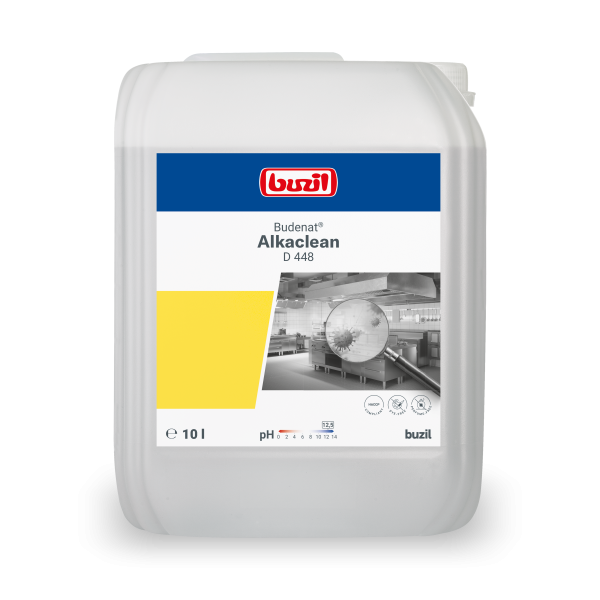Utilization
Soiling
-
Organic / inorganic contamination (grease, oil, protein, starch etc.)
-
Microbes (bacteria, viruses etc.)
Material compatibility
-
Clinker and terracotta
-
PVC safety flooring
-
Sandstone
-
Ceramic tiles
-
Basalt
-
Granite
-
Stainless steel
-
Enamel
-
Plastics
-
Gneiss
-
Magnesite screed
-
Quartzite
-
Gabbro
-
Ceramic hobs
-
Asphalt flooring
-
Safety tiles
-
Ovens, grills and convection ovens
-
Chrome
-
PVC composite decking
-
Cast stone and terrazzo | bitumen-bound
-
Concrete stone and terrazzo | non-calcareous
-
PVC | heterogeneous, multilayer
-
PVC | homogeneous
-
PVC | PU seal
-
Green sandstone | Anröchter stone
-
Conductive floor coverings
-
Quartz vinyl
-
Porcelain stoneware tiles
-
Synthetic resin filler coverings
Product Information
- Works on the basis of quaternary ammonium compounds
- Cleaning and disinfection in one step
- Good grease and dirt dissolving ability
- Effective against bacteria (including Salmonella enterica, Listeria monocytogenes), yeasts (including Sacharomyces cerevisiae), moulds and enveloped viruses
- Spectrum of activity: bactericidal, yeasticidal, fungicidal, limited virucidal
- Short exposure times
- Perfume and dye-free
- Meets the requirements within the framework of an HACCP concept
Area of application
- for surface disinfection in the food industry and in the food processing industry, as well as in the kitchen area and in the healthcare sector, in public facilities, etc.
- for all water and alkali-resistant surfaces, such as walls and work surfaces as well as kitchen and work equipment/machines and floor coverings
Application and dosage
- First remove coarse dirt from the surface. We then recommend using suitable methods (e.g. wet wiping, non-mechanical methods) and rinsing after drying or after the exposure time has elapsed.
- Recommended use for surface disinfection (spectrum of effects/exposure times):
- bactericidal, yeasticidal – EN 1276, EN 13697, EN 16615, EN 1650: with and without mechanics 5 min. 1.0 %
- fungicidal – EN 13697, EN 1650: without mechanics 15 min. 3.0 %
- limited virucidal – EN 14476, EN 16777: without mechanics 5 min. 5.0% or 15 min. 2.0%
- For activity against food strains (Salmonella enterica, Listeria monocytogenes and Sacharomyces cerevisiae), apply the product without mechanical action at a dilution of 1.0% and let it act for 5 minutes. For surfaces that won’t come into contact with food, allow the product to dry. Rinsing with water is required only for those surfaces that will come into contact with food.
-
100 - 500 Millilitre / 10 liter Water
-
100 - 500 Millilitre / 10 liter Water
- Apply fresh application solutions and consume them within 24 hours at the latest.
Note
- Ingredients: 100g contains: 10 g Alkyl(C12-16)dimethylbenzylammonium chloride
- BAuA Reg. No. N-114147.
- Surfaces that come into contact with food or the skin must be rinsed with drinking water after disinfection.
- Absorb unintentionally released product with liquid-binding material (sand, diatomaceous earth, universal binder).
- Use biocides safely. Always read the labelling and the product information before use.
- Do not allow the product to enter the sewage system or water bodies undiluted.
- Contribute emptied packaging to recycling.
- Use biocides safely. Always read the labelling and the product information before use.
- Consume opened containers within 9 months.
- Please note the expiry date on the original packaging.
- Changes or variations in colour of the product do not impact on the quality. The product image may differ in colour and shape from the original.
- Commercial use only
Environmental Information
Proportion of easily degradable ingredients
100 %
Phosphorus content
0 mg/g
Palm oil-based raw materials - RSPO-certified share
contain no palm oil-based raw materials
The proportion of easily degradable ingredients refers to the proportion of organic ingredients that are defined as “easily biodegradable” according to OECD 301 or Detergent Regulation (EC) No. 648/2004. The value of the phosphorus content refers to elemental phosphorus. Palm oil is an important renewable source for the production of raw materials. The Roundtable on Sustainable Palm Oil (RSPO), founded in 2004, promotes sustainable cultivation methods for palm oil. This results in a certification system and the possibility of declaring raw materials as “RSPO-certified”.
Sales units
- D448-0010RA: 1 x 10 l canister
Classification according to CLP
Danger marking
Danger
Hazard information
- H290: May be corrosive to metals.
- H314: Causes severe skin burns and eye damage.
- H335: May cause respiratory irritation.
- H410: Very toxic to aquatic life with long lasting effects.
Safety instructions
- P273: Avoid release to the environment.
- P280: Wear protective gloves/protective clothing/eye protection/face protection.
- P303+P361+P353: IF ON SKIN (or hair): Take off immediately all contaminated clothing. Rinse skin with water or shower.
- P305+P351+P338: IF IN EYES: Rinse cautiously with water for several minutes. Remove contact lenses, if present and easy to do. Continue rinsing.
- P310: Immediately call a POISON CENTER/doctor.
- P501: Dispose of contents/containers in accordance with local and national regulations.
Download area
- Operating instructions
- Safety Data Sheets
- Technical Data Sheets
- Environmental Information


